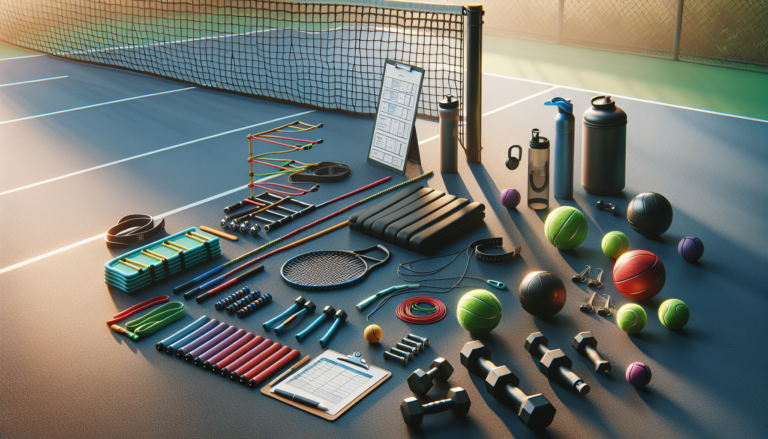Introduction to Tennis Fitness
Tennis is a physically demanding sport that requires a combination of strength, power, endurance, and agility. To perform at their best on the court, tennis players need to engage in tennis-specific exercises and conditioning routines that target the key areas of fitness essential for the game. A well-rounded tennis fitness program should include exercises that improve overall strength, power, endurance, and on-court movement while also focusing on injury prevention.
Customized workout programs are essential for individual goals and health. Each player has unique strengths, weaknesses, and physical capabilities that need to be considered when designing a fitness plan. Working with a certified tennis performance specialist can help players develop a tailored program that addresses their specific needs and goals.
Dynamic Warm-Ups for Tennis Players
Importance of Dynamic Warm-Ups
Dynamic warm-ups are a crucial component of any tennis fitness routine. Unlike static stretching, dynamic warm-ups involve active movements that prepare the body for the intense physical demands of tennis. These exercises help increase blood flow, raise body temperature, and activate the muscles and joints used during play. Incorporating dynamic warm-ups into your pre-match routine can enhance performance and significantly reduce the risk of injury.
Examples of Effective Dynamic Warm-Up Exercises
Some effective dynamic warm-up exercises for tennis players include:
- Jogging or skipping
- High knees and butt kicks
- Walking lunges with rotation
- Arm circles and shoulder rotations
- Leg swings (front-to-back and side-to-side)
- Dynamic stretches like walking toe touches and inchworms
These tennis-specific exercises mimic the movements used during the game and help prepare the body for the quick starts, stops, and changes of direction required on the court. Aim to perform your dynamic warm-up for 5-10 minutes before starting your tennis session.
Core Strength and Stability
Why Core Strength is Crucial for Tennis Players
Core strength is a vital aspect of tennis fitness. The core muscles, which include the abs, obliques, and lower back, play a critical role in almost every movement on the tennis court. A strong and stable core helps players maintain balance, generate power, and control body positioning during shots. It also contributes to improved endurance and reduces the risk of lower back injuries, which are common among tennis players.
Top Core Exercises for Tennis Players
Incorporating these tennis-specific exercises into your fitness routine can help develop the core strength necessary for optimal performance:
- Plank variations (front, side, and stability ball)
- Russian twists
- Bicycle crunches
- Medicine ball rotations
- Woodchops (using cables or resistance bands)
- Supermans
Aim to perform core exercises 2-3 times per week, with 2-3 sets of 10-15 repetitions for each exercise. As you progress, increase the difficulty by adding resistance or performing more advanced variations.
Upper Body Strength Training
Benefits of Upper Body Strength in Tennis
Upper body strength is essential for tennis players, as it directly impacts the power and control of shots. Strong shoulders, arms, and chest muscles allow players to generate more racket head speed, which translates to faster serves and groundstrokes. Additionally, well-developed upper body muscles help maintain proper technique throughout long matches and reduce the risk of shoulder and elbow injuries.
Effective Upper Body Exercises
When designing an upper body strength training program for tennis, focus on exercises that target the key muscle groups used during play:
- Dumbbell or cable rows
- Push-ups (traditional, diamond, or plyometric)
- Dips
- Lateral raises
- Shoulder external rotations
- Bicep curls and tricep extensions
Perform upper body strength exercises 2-3 times per week, with 2-3 sets of 8-12 repetitions for each exercise. Use weights that challenge you but allow you to maintain proper form throughout the entire range of motion.
Lower Body Strength and Power
Importance of Lower Body Strength
Tennis is a game of quick starts, stops, and changes of direction, all of which rely heavily on lower body strength and power. Strong legs, glutes, and calves provide the foundation for explosive movements, such as sprinting to the ball, jumping for overheads, and lunging for wide shots. Developing lower body strength also improves stability and balance, reducing the risk of ankle and knee injuries.
Key Lower Body Exercises
Incorporate these best exercises for tennis players to build lower body strength and power:
| Exercise | Sets | Reps |
|---|---|---|
| Squats (bodyweight, dumbbell, or barbell) | 3 | 8-12 |
| Lunges (forward, reverse, or lateral) | 3 | 8-12 (each leg) |
| Step-ups | 3 | 10-15 (each leg) |
| Deadlifts (dumbbell or barbell) | 3 | 6-10 |
| Calf raises | 3 | 15-20 |
| Box jumps or squat jumps | 3 | 6-8 |
Perform lower body exercises 2-3 times per week, focusing on proper form and gradually increasing weight or resistance as you progress.
Injury Prevention Strategies
Common Tennis Injuries and How to Prevent Them
While engaging in a regular tennis fitness routine can help reduce the risk of injury, it’s essential to be aware of the most common tennis injuries and take steps to prevent them. Some of the most frequent injuries among tennis players include:
- Tennis elbow: An overuse injury causing pain on the outer part of the elbow. Prevent tennis elbow by maintaining proper technique, using the right grip size, and performing forearm strengthening exercises.
- Rotator cuff tears: Damage to the muscles and tendons surrounding the shoulder joint. Prevent rotator cuff injuries by incorporating shoulder strengthening and stability exercises into your routine and avoiding overuse.
- Ankle sprains: Caused by sudden twists or awkward landings. Prevent ankle sprains by wearing supportive shoes, performing balance and proprioception exercises, and properly warming up before play.
- Stress fractures: Tiny cracks in bones, often resulting from repetitive stress. Prevent stress fractures by cross-training, wearing appropriate footwear, and gradually increasing training intensity.
Prehab Exercises for Injury Prevention
Incorporating prehab exercises into your tennis fitness routine can help address muscle imbalances, improve flexibility, and reduce the risk of injury. Some effective prehab exercises include:
- Wrist extensions and flexions
- Shoulder internal and external rotations with resistance bands
- Single-leg balance exercises
- Calf and hamstring stretches
- Scapular stabilization exercises (e.g., prone Y’s and T’s)
- Glute activation exercises (e.g., clamshells and bridges)
Perform prehab exercises 2-3 times per week, focusing on controlled movements and proper form.
Endurance Training for Tennis
Why Endurance is Important in Tennis
Endurance training is crucial for tennis players, as matches can last for several hours and require sustained high-intensity effort. A well-developed aerobic base allows players to maintain their performance throughout long rallies and recover quickly between points. Good endurance also helps delay fatigue, which can lead to decreased accuracy and increased risk of injury.
Best Endurance Exercises for Tennis Players
To improve endurance for tennis, incorporate a mix of steady-state cardio and high-intensity interval training (HIIT) into your fitness routine:
- Steady-state cardio: Jogging, cycling, or swimming at a moderate pace for 30-60 minutes
- On-court interval drills: Alternating between high-intensity rallies and active recovery periods
- Off-court HIIT: Exercises like sprints, burpees, jump squats, and mountain climbers performed in short, intense intervals
- Agility ladder drills: Quick footwork patterns that mimic tennis movements
Aim to perform endurance exercises 2-3 times per week, gradually increasing duration and intensity as your fitness improves.
Flexibility Training for Tennis Players
Benefits of Flexibility in Tennis
Flexibility training is an often-overlooked aspect of tennis fitness, but it plays a vital role in performance and injury prevention. Adequate flexibility allows players to move more efficiently on the court, achieve a wider range of motion in their shots, and maintain proper technique. Flexible muscles and joints are also less prone to strains and sprains, which are common tennis injuries.
Effective Flexibility Exercises
A comprehensive flexibility training program should include a combination of dynamic stretches and static stretches. Dynamic stretches are performed before practice or matches to prepare the body for movement, while static stretches are best done after play to help muscles relax and recover.
Dynamic stretches for tennis players:
- Arm swings and circles
- Leg swings (front-to-back and side-to-side)
- Walking lunges with rotation
- Dynamic hamstring stretches
Static stretches for tennis players:
- Shoulder and chest stretches
- Quadriceps and hip flexor stretches
- Hamstring and calf stretches
- Trunk rotations and side bends
Hold each static stretch for 15-30 seconds and repeat 2-3 times on each side. Perform flexibility exercises daily, especially after tennis sessions, to maintain and improve range of motion.
The Martin Method for Tennis Fitness
Overview of The Martin Method
The Martin Method is a comprehensive training system designed specifically for tennis players. Developed by renowned strength coach Jeff Martin, this approach focuses on developing the key physical attributes necessary for optimal tennis performance. The method has gained popularity among professional and amateur players alike due to its proven track record of improving on-court performance and reducing the risk of injuries.
The Nine Threads of The Martin Method
The Martin Method identifies nine essential physical attributes, or “threads,” that tennis players should develop:
- Bilateral Strength: Building total-body strength, which is the foundation for power development and endurance.
- Anti-Rotation & Rotational Control: Enhancing a player’s ability to maintain stability during the rotational movements required in tennis.
- Force Absorption: Improving the ability to manage and absorb the physical forces encountered during tennis movements.
- Force Expression: Developing the capacity to generate power during tennis-specific movements.
- Unilateral Power: Building strength and power in each leg independently to enhance balance and stability.
- Repeated Power: Improving the ability to perform dynamic movements repeatedly without a significant decrease in power output.
- Multi-Directional Speed: Enhancing the ability to move quickly and efficiently in various directions on the court.
- High Aerobic Capacity: Developing the endurance necessary to sustain high-intensity performance throughout a match.
- Full Body Flexibility: Maintaining and improving range of motion in all joints to support efficient movement and reduce the risk of injury.
By addressing each of these threads through targeted exercises and training protocols, The Martin Method helps tennis players build a strong, resilient, and high-performing body that can withstand the demands of the game.
Engaging with Certified Trainers
Benefits of Working with Certified Trainers
While it’s possible to design and implement a tennis fitness program on your own, working with a certified trainer can provide numerous benefits. A qualified tennis performance specialist can:
- Assess your current fitness level and identify areas for improvement
- Create a customized training plan that aligns with your goals and schedule
- Provide guidance on proper form and technique to maximize results and minimize the risk of injury
- Monitor your progress and make adjustments to your program as needed
- Offer motivation and accountability to help you stay on track
Certified trainers, such as those recognized by the International Tennis Performance Association (iTPA) or the United States Tennis Association (USTA), have the knowledge and experience to help you optimize your tennis fitness routine for peak performance.
Finding the Right Trainer for You
When searching for a tennis performance specialist, consider the following factors:
- Credentials and certifications
- Experience working with tennis players at your level
- Training philosophy and approach
- Availability and location
- Personal rapport and communication style
Look for a trainer who takes the time to understand your unique needs, goals, and preferences and who can create a program that challenges you while respecting your limits. Don’t hesitate to ask for references or testimonials from past clients to get a better sense of a trainer’s effectiveness and track record.
Conclusion: Building a Comprehensive Tennis Fitness Routine
Putting It All Together
Creating a well-rounded tennis fitness routine involves combining the various elements discussed in this article: dynamic warm-ups, core strength, upper and lower body strength training, injury prevention strategies, endurance training, and flexibility work. By addressing each of these components consistently, you can develop the physical attributes necessary for optimal performance on the court.
When designing your program, consider your current fitness level, goals, and schedule. Start with a manageable workload and gradually increase the intensity and volume over time to allow your body to adapt and avoid overtraining. Remember to listen to your body and give yourself adequate rest and recovery between training sessions.
Staying Consistent and Motivated
Consistency is key when it comes to seeing results from your tennis fitness efforts. To stay motivated and on track, try the following strategies:
- Set specific, measurable, achievable, relevant, and time-bound (SMART) goals
- Track your progress using a workout log or fitness app
- Find a training partner or join a tennis fitness community for accountability and support
- Celebrate your successes and learn from your setbacks
- Regularly reassess your goals and adjust your program as needed
By making tennis fitness a priority and committing to a consistent, well-designed training program, you can take your game to the next level while reducing your risk of injury and enhancing your overall health and well-being.






